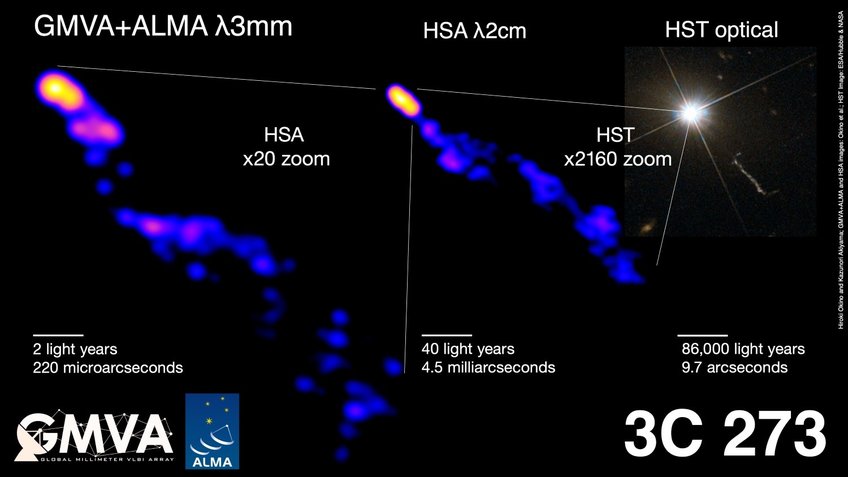International team observes innermost structure of quasar 3C 273
At the core of almost every galaxy is a supermassive black hole. But there are many different types. Quasars, for example, are one of the brightest and most active types of galaxy centres. An international group, including researchers from the Max Planck Institute for Radio Astronomy in Bonn, presents new observations of the first quasar ever identified. This "quasi-stellar object", named 3C 273, is located at a distance of about 1.9 billion light years in the direction of the constellation Virgo. The new radio images trace the jet down to its origin and show how its width varies with increasing distance from the central black hole.

Zoom into the centre: The image on the left shows the deepest view yet into the plasma jet of quasar 3C 273, allowing us to study in more detail how the jet is focused. The jet extends for hundreds of thousands of light years beyond the galaxy, as can be seen in the optical image on the right, taken by the Hubble Space Telescope. The researchers used radio images at different wavelengths and angular resolutions to measure the expansion of the entire jet. The radio interferometers used here are the Global Millimetre VLBI Array (GMVA), the Atacama Large Millimetre/submillimetre Array (ALMA) and the High Sensitivity Array (HSA).
© Hiroki Okino and Kazunori Akiyama; GMVA+ALMA and HSA images: Okino et al.; HST Image: ESA/Hubble & NASA.
Active supermassive black holes emit narrow, incredibly powerful jets of plasma that escape at nearly the speed of light. Thomas Krichbaum, astronomer at the Max Planck Institute for Radio Astronomy (MPIfR) in Bonn, Germany, one of the leading authors of the work, says: "These jets have been studied over many decades, yet the details of jet formation are not well understood and a topic of ongoing research. An unresolved issue has been how and where the jets are collimated into a narrow beam, which allows them to propagate to extreme distances beyond their host galaxy. Astronomers now realize that these far outreaching jets may even affect galactic evolution. These new radio observations are probing as deep as 0.5 light years into the heart of the black hole in 3C273 into the region, where the jet plasma flow is collimated into a narrow beam."
This new study, published today in The Astrophysical Journal, includes observations of the 3C 273 jet at the highest angular resolution to date. The ground-breaking work was made possible by using a closely coordinated set of radio antennas around the globe, a combination of the Global Millimeter VLBI Array (GMVA) and the Atacama Large Millimeter/submillimeter Array (ALMA) in Chile. In addition, coordinated observations were also made with the High Sensitivity Array (HSA) to extend the study of 3C 273 to larger scales, in order to also measure the global shape of the jet. The data in this research were collected in 2017, around the same time that the Event Horizon Telescope (EHT) observations revealed the first images of a black hole in M87, which is a radio galaxy about 20 times closer than 3C273.
The MPIfR is the leading institution of the GMVA. Data are processed at the correlator center in the institute, and the observations are coordinated from the institute.
"3C 273 has been studied for decades as the ideal closest laboratory for quasar jets," says Hiroki Okino, lead author of this paper and a PhD student at the University of Tokyo and National Astronomical Observatory of Japan. "However, even though the quasar is a close neighbor, until recently, we didn't have an eye sharp enough to see where this narrow powerful flow of plasma is shaped."
The image of the 3C 273 jet gives scientists the very first view of the innermost part of the jet in a quasar, where the collimation or narrowing of the beam occurs. The team further found that the angle of the plasma stream flowing away from the black hole is tightened up over a very long distance. This narrowing part of the jet continues incredibly far, well beyond the area where the black hole's gravity rules.
"It is striking to see that the shape of the powerful stream is slowly formed over a long distance in an extremely active quasar. This has also been discovered nearby in much fainter and less active supermassive black holes," says Kazunori Akiyama, research scientist at MIT Haystack Observatory and project lead. "The results pose a new question: how does the jet collimation happen so consistently across such varied black hole systems?"
The new, extremely sharp images of the 3C 273 jet were made possible by the inclusion of the ALMA interferometer, which was phased-up to act as a single big radio-telescope. The GMVA and ALMA were connected across continents using a technique called very long baseline interferometry (VLBI) to obtain highly detailed information about distant astronomical sources. The remarkable VLBI capability of ALMA was enabled by the ALMA Phasing Project (APP) team. The international APP team, led by MIT Haystack Observatory and the MPIfR, developed the hardware and software to turn ALMA, an array of sixty-six telescopes, into the world's most sensitive astronomical interferometry station. Collecting data at these wavelengths greatly increases the resolution and sensitivity of the VLBI array. This capability was fundamental not only to the GMVA but also to the EHT's black hole imaging work.
Anton Zensus, director at the MPIfR and coauthor of the present work, concludes: "ALMA joining the global VLBI networks is a complete game-changer for black hole science. With this breakthrough, we obtained the first-ever images of supermassive black holes, and now in cases like 3C 273 it is helping us to see for the first time incredible new details about how black holes power their jets also in such more distant objects."






